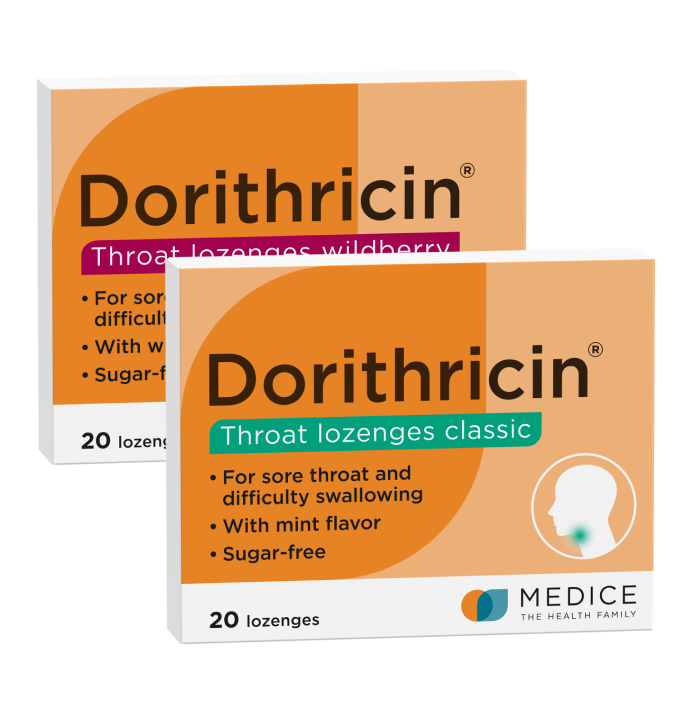Dorithricin® -
Tonsillitis

Tonsillitis
Tonsillitis is usually caused by bacteria. Typical symptoms include fever and a strong feeling of general malaise alongside severe throat pain and swallowing difficulties. In this case, it makes sense to visit the doctor.
![]() Good to know:
Good to know:
In consultation with a doctor, Dorithricin® throat lozenges can be taken to support the prescribed treatment in order to provide rapid and targeted relief for a sore throat and swallowing difficulties.
Tonsillitis - Fact sheet
- Medical term Tonsillitis / tonsils = rounded mass of pharyngeal tissue / -itis = inflammation)
- Causes:
Usually bacteria (e.g. streptococci, but also staphylococci, pneumococci among others) - Symptoms:
Severe throat pain, swallowing difficulties, tight feeling in the throat, fever, fatigue, headache, general malaise, swollen tonsils, sometimes coated with pus-filled spots - Treatment:
Possibly antibiotics, increased fluid intake, soft food, paracetamol for fever;
Dorithricin® to alleviate sore throat and swallowing difficulties in consultation with a doctor

Tonsillitis: Causes
Most cases of tonsillitis are caused by bacteria –β-haemolysing streptococci in particular play a central role here.
In many cases, tonsillitis is preceded by a viral infection of the throat which allows bacteria to settle and multiply, which in turn can lead to tonsillitis. This is called a bacterial superinfection.
Tonsillitis: Symptoms
The typical symptoms of tonsillitis include rapidly worsening sore throat and swallowing difficulties accompanied by fever and a general feeling of malaise.
The most important symptoms of acute tonsillitis at a glance:
- Sore throat
- Swallowing difficulties
- Fever
- Headache
- General malaise
- Swollen lymph nodes in the neck
- Reddened, swollen tonsils
In children, abdominal pain and vomiting are also possible.
Sometimes, an inspection of the throat will reveal whether the tonsillitis is viral or bacterial.
- Mucous membranes are swollen and shiny red, no pus formation
-> typical of viral tonsillitis - Severely reddened tonsils, whitish-yellow pus spots on the tonsils, severe pain
-> typical of bacterial tonsillitis
In any case, only your doctor can provide an exact diagnosis. If you have signs of tonsillitis, consult your GP or an otolaryngologist (ear, nose and throat specialist).
How does tonsillitis occur?
Tonsillitis commonly presents as a result of a viral infection, especially when bacteria settle and multiple on top of a viral infection (bacterial superinfection).
Above and beyond this, a separate bacterial infection, i.e. without a previous virus infection, is also possible.
![]() Good to know:
Good to know:
Chronic tonsillitis is usually associated with less pronounced symptoms.
Tonsillitis: Treatment
Different medicinal and non-medicinal options are available to treat tonsillitis.
Medicinal options
- For bacterial tonsillitis: Antibiotics prescribed by a doctor
- Complementary remedies to relieve a sore throat and swallowing difficulties

- Works within minutes1
- Lasts for hours1
- Fights bacteria and viruses2
Dorithricin® provides rapid and lasting pain relief:
For a sore throat and swallowing difficulties, Dorithricin® provides rapid, reliable relief. That is because Dorithricin® contains a local analgesic that quickly alleviates the pain. In consultation with a doctor, Dorithricin® throat lozenges can thus also be taken for acute pain relief in tonsillitis and can effectively support the existing treatment measures.
Continue reading to find out more about Dorithricin®.
Other medicines that are sometimes used to treat tonsillitis include anti-inflammatory and decongestant remedies, as well as paracetamol in cases of high fever. Ask your doctor or pharmacist for advice.
Non-medicinal options
- Drink plenty of fluids (e.g. cold chamomile tea, sage tea) – important: fruit juices are not suitable because of their acidity
- Eat soft, lightly seasoned foods
- Abstain from smoking
Surgery for tonsillitis
![]() Good to know:
Good to know:
Surgical removal of the tonsils (tonsillectomy) can sometimes be useful if tonsillitis occurs more frequently (three to four times a year) or when the tonsils are very large in children. Ask your doctor for advice.


Preventing tonsillitis
Bacterial tonsillitis often develops on top of a viral infection: Bacteria settle and sometimes lead to so-called bacterial superinfections, such as tonsillitis.
To prevent this, you should react quickly to a sore throat and initiate appropriate treatment early on: Dorithricin® not only alleviates pain but also fights the pathogens (bacteria and viruses2), thereby slowing down the infection before a sore throat becomes worse.
The next time you feel a cold coming on or have pharyngitis, remember to take Dorithricin®!

